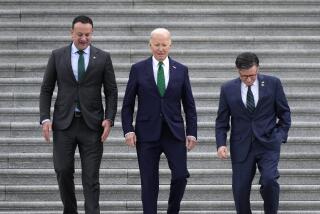Money Supply Climbs $4.2 Billion
- Share via
NEW YORK — The nation’s basic money supply rose $4.2 billion in mid-April, the Federal Reserve Board reported Thursday.
Although the increase was larger than expected and pushed the money supply above the Fed’s growth target, there was virtually no reaction in the credit markets.
The Fed said M1 rose to a seasonally adjusted $645.6 billion in the week ended April 21 from a revised $641.4 billion in the previous week.
M1 includes cash in circulation, deposits in checking accounts and non-bank travelers checks.
For the latest 13 weeks, M1 averaged $636.2 billion, an 8% seasonally adjusted annual rate of gain from the previous 13 weeks.
The Fed, in its attempt to provide enough money to stimulate non-inflationary economic growth, has said it would like to see M1 grow in a range of 3% to 8% from the fourth quarter of 1985 through the final quarter of 1986.
$4 Billion Above Target
“The increase in money was larger than expected,” said David Jones, an economist with the government securities trading firm Aubrey G. Lanston & Co. The markets had been expecting a gain of $2.5 billion to $3 billion, he said.
The latest jump brings the money supply more than $4 billion above the Fed’s upper target.
However, Jones said he doesn’t expect the Fed to tighten its grip on credit, which would increase interest rates.
The economist also said he expects the Fed to wait for more economic data before making another move to stimulate the economy by lowering interest rates. There have been several discouraging economic reports out of Washington in recent days.
The Fed last cut its discount rate--what it charges on loans to member banks--to 6.5% from 7% on April 18.
“I would emphasize that money remains a relatively low priority with the Fed,” Jones said. “I think the Fed (will) hold a steady stance. In the weeks immediately ahead, there really isn’t going to be much action on the Fed front.”
The Fed is more concerned with making sure that it doesn’t precipitate a further decline in the dollar, Jones said. Lower interest rates make the dollar a less attractive investment.
In other reports released on Thursday:
- The Federal Reserve Bank of New York reported that commercial and industrial loans at major New York City banks fell $1.536 billion in the week ended April 23, compared to a gain of $1.055 billion a week earlier.
- The Federal Reserve said bank borrowings from the Federal Reserve System averaged $367 million in the week ended Wednesday, up from $297 million in the previous week.
More to Read
Inside the business of entertainment
The Wide Shot brings you news, analysis and insights on everything from streaming wars to production — and what it all means for the future.
You may occasionally receive promotional content from the Los Angeles Times.









